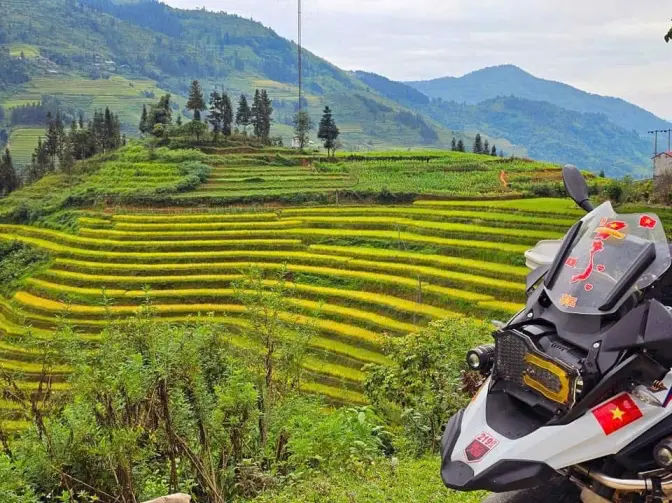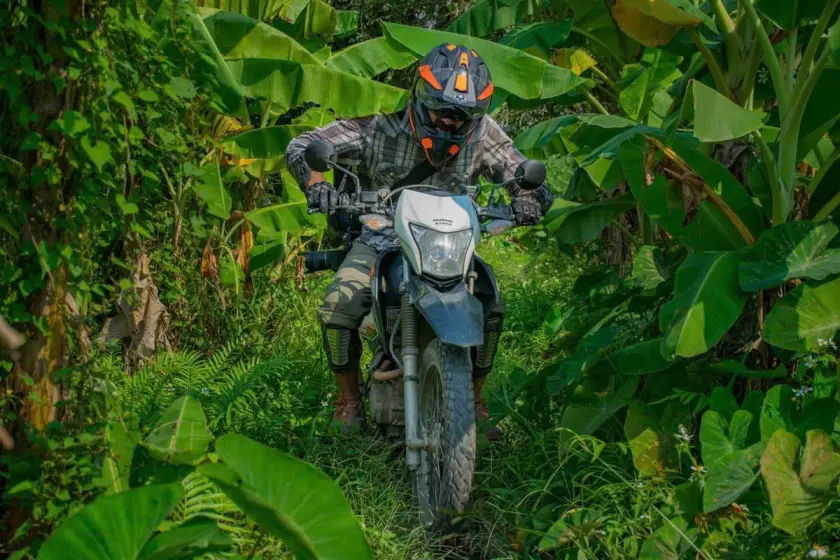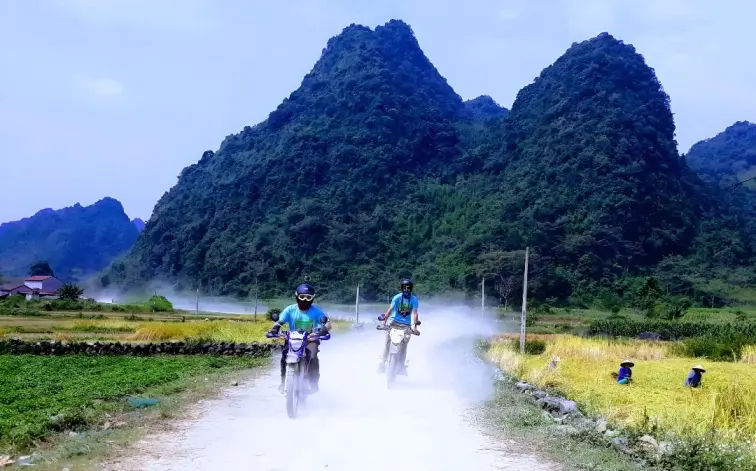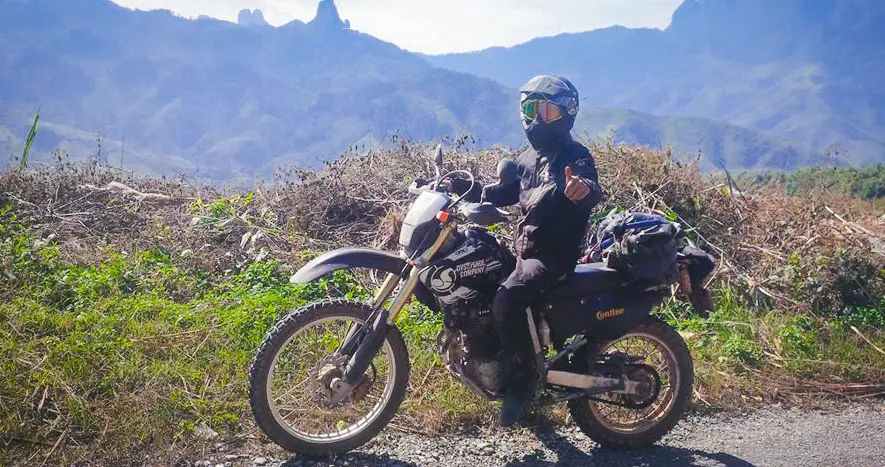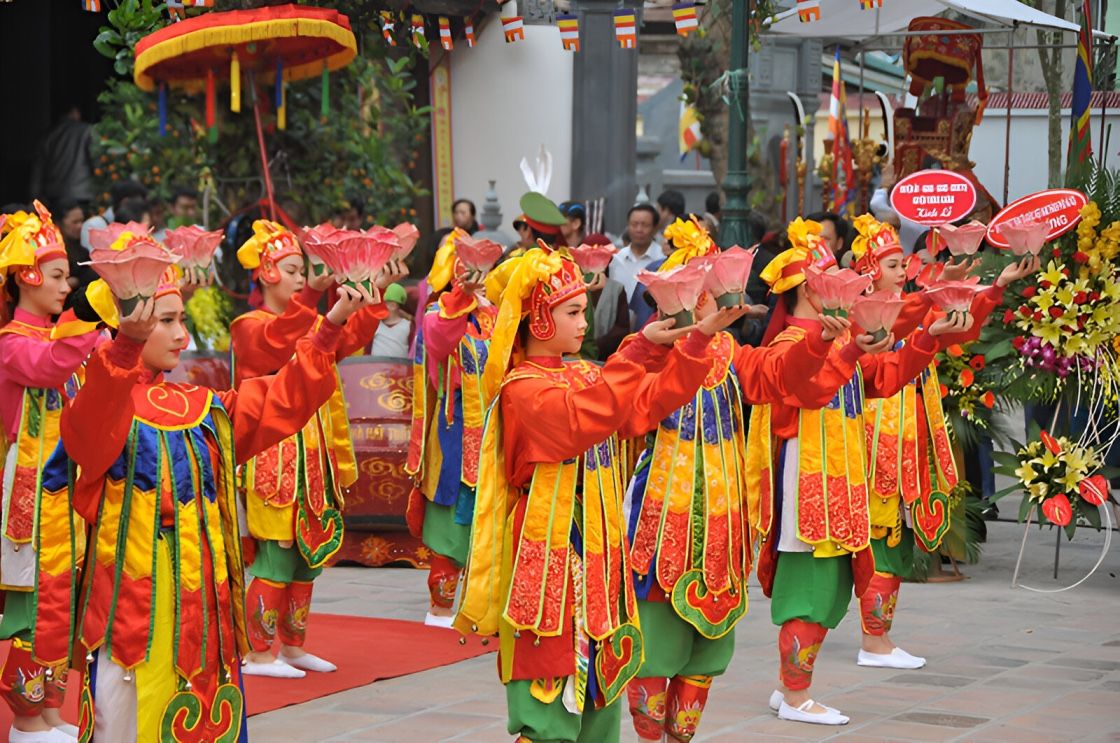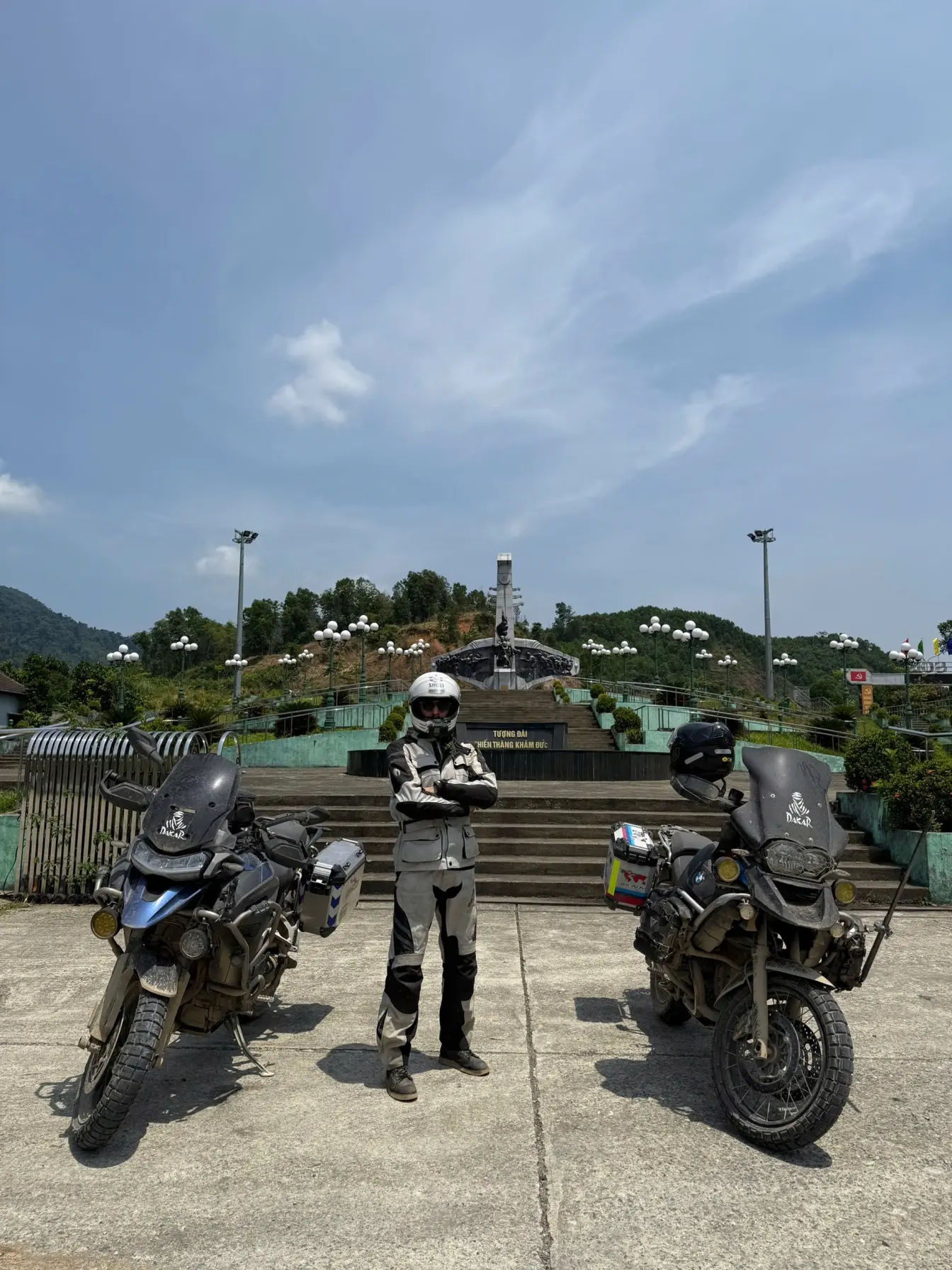
Riding a motorbike across Vietnam is the ultimate adventure. From the misty mountains of the North to the tropical South, every road tells a story. I rode the Ha Giang Loop, followed the Ho Chi Minh Trail, and stopped at roadside kitchens for pho and coffee with locals. A motorbike gives freedom no bus or train can match—you feel every curve, every scent, every view. Whether you dream of a month-long ride from Hanoi to Ho Chi Minh City or a shorter motorbike tour, Vietnam delivers an exact match.
A Complete Guide To Riding Motorbike through Vietnam
The best way to experience Vietnam (of-course if you’re into riding a motorbike), is from the seat of a motorcycle. Instead of watching the landscape blur past on buses or trains, I felt the wind on my face, the mountains rising ahead, and the freedom to stop whenever a view demanded it.
On my rides, I decided when to pull over for steaming pho at a roadside kitchen, wander through a fishing village, or follow a detour into rice terraces glowing under the sun. Each stop turned into a story, and each mile revealed a side of Vietnam most travelers never touch.
Choosing to ride means choosing adventure. On the Ha Giang Loop, I pushed through tight mountain curves. Along the Ho Chi Minh Trail, I cruised past jungles and remote villages. By the time I reached Ho Chi Minh City from Hanoi, I carried memories only the road could give. Every challenge shaped the journey, and every victory stayed with me. For anyone planning Vietnam motorbike tours, the road itself becomes the destination.
- Check out Ho Chi Minh Trail motorbike tours
Vietnam’s cross-country routes
The most iconic journey for motorbike travelers in Vietnam is the ride between Hanoi and Ho Chi Minh City – a trip that can be done in either direction, covering nearly the entire length of the country. Most riders spend three to six weeks on this adventure, depending on how often they stop and explore.
There are several main route choices, each with its own character. The Ho Chi Minh Road is a favorite among many riders. Winding through lush mountains and quiet countryside, it offers breathtaking scenery and far less traffic than the main highway. This route is slower, but it’s peaceful and deeply rewarding, giving you a closer look at Vietnam’s rural heart.
By contrast, National Highway 1A is the most direct north-south road. It passes through major cities like Hue, Da Nang, and Nha Trang, making it convenient for quick connections. However, it is also busy, with heavy truck traffic and less appealing scenery, so it can feel stressful at times.
Riding Vietnam from North to South
Many riders end up mixing both: taking Highway 1A when they need to move quickly, and switching to the Ho Chi Minh Road for the most rewarding stretches.
1. The Northern Loop
- Key Stops: Hanoi, Mai Chau, Son La, Dien Bien Phu, Sapa, Ha Giang.
The adventure begins in Hanoi, where the energy of Vietnam is at its loudest. It’s here you’ll stock up on gear, tune your bike, and taste your first bowls of steaming phở before heading out. From Hanoi, the road quickly climbs into the countryside, winding past rice paddies and limestone cliffs on the way to Mai Chau, a valley surrounded by green mountains and stilt houses.
- Check out Northern Vietnam Motorcycle tours
Continuing west, the route to Son La and Dien Bien Phu is lined with terraced hillsides and small villages. Dien Bien Phu itself carries the weight of history, being the site of the famous battle that ended French colonial rule. From here, you can loop north to Sapa, where misty mornings rise over endless rice terraces and Fansipan – the “Roof of Indochina”.
The highlight for many riders is the Ha Giang Extreme Loop. This detour of 4-5 days takes you along Vietnam’s most dramatic roads, where limestone peaks pierce the sky and remote villages showcase the traditions of ethnic minority groups. It’s challenging, unforgettable, and often the crown jewel of the entire trip.
- Distance: Around 1,200 km if you include Sapa and Ha Giang.
- Recommended Stay: 7-10 days to explore the mountains without rushing.
2. The Central Coast
- Key Stops: Phong Nha, Hue, Da Nang, Hoi An.
Heading south from Hanoi, the route joins the Ho Chi Minh Trail, a quieter, greener road that leads to Phong Nha-Ke Bang National Park. This is home to the largest caves in the world, including the otherworldly Son Doong. Even if you don’t venture underground, the park’s limestone karsts and rivers make it a magical stop.
From there, the road continues to Hue, Vietnam’s imperial city. Between its crumbling citadel walls, royal tombs, and bowls of spicy bún bò Huế, the city blends history with vibrant street life.
Then comes the legendary Hai Van Pass. Made famous by the BBC’s Top Gear, this winding coastal road between Hue and Da Nang offers sweeping views of mountains and sea. It’s a short ride, but one of the most memorable stretches in the country.
The descent leads you into Da Nang, a modern seaside city, and further on to Hoi An. With its lantern-lit streets, colorful markets, tailors, and quiet beaches, Hoi An is the perfect place to rest and recharge before continuing south.
- Distance: Hanoi to Hoi An is about 900 km, depending on detours.
- Recommended Stay: 5-7 days to enjoy both the coast and cultural sites.
3. The Central Highlands
- Key Stops: Kontum, Pleiku, Buon Ma Thuot, Dalat.
From Hoi An, many travelers stick to the coast, but the Central Highlands offer something entirely different: wild nature, cooler climates, and far fewer tourists. The western branch of the Ho Chi Minh Trail winds through rugged landscapes, where jungle-covered hills stretch for miles and traffic is scarce.
Passing through Kontum and Pleiku, you’ll encounter small towns where the pace of life slows, and where tribal traditions remain strong. Further south, Buon Ma Thuot is known as Vietnam’s coffee capital – perfect for a caffeine-fueled pause.
Finally, the road ascends into Dalat, the “City of Eternal Spring.” French colonial villas, flower gardens, and cascading waterfalls give Dalat a romantic feel, though it’s also quirky enough to host the famous Crazy House, a surreal architectural wonder. The cooler air makes it a welcome break after the heat of the lowlands.
- Distance: Hoi An to Dalat is about 800-900 km, depending on the chosen routes.
- Recommended Stay: 5-6 days for a relaxed pace through the highlands.
4. The Southern Vietnam routes
- Key Stops: Mui Ne, Ho Chi Minh City, Mekong Delta.
Leaving Dalat, the road spirals down through forests and valleys until it reaches the coast. The descent is thrilling, with sweeping views at every turn. Soon, you’ll find yourself in Mui Ne, where dunes roll into the sea and the wind attracts kitesurfers from around the world. The red and white dunes are striking at sunrise, and you can even try sandboarding before cooling off with fresh seafood.
The ride then continues to Ho Chi Minh City, a metropolis that pulses with energy, motorbikes, and endless things to do. Many riders end their trip here, selling their bike, celebrating with new friends, and looking back on the thousands of kilometers behind them.
But if time allows, the journey can stretch further into the Mekong Delta. Here, the pace slows as the road weaves through coconut groves, rice paddies, and countless waterways. Can Tho’s floating markets, Ben Tre’s palm-lined lanes, and Chau Doc’s riverside temples show a gentler side of Vietnam, where life moves to the rhythm of the river. It’s a peaceful way to close the adventure, trading mountain passes for ferry crossings and street traffic for wooden boats at sunrise.
- Distance: Dalat to Ho Chi Minh City via Mui Ne is about 350 km. Add another 300-400 km if exploring the Delta.
- Recommended Stay: 3-4 days in the south, plus 3-4 more if heading into the Delta.
Expenses for a Motorbike Road Trip in Vietnam
Average daily costs:
Traveling by motorbike in Vietnam is affordable. On average, you’ll spend around $17-36 per day, covering fuel (about $4-6 for a full tank), local meals (as little as $5-10 per meal), and budget accommodation (guesthouses from $8-20 a night).
Buying vs renting a bike:
Renting a bike is easier if you’re short on time, expect $10-15 per day for a scooter-or $20+ for larger bikes under 150cc. Buying can be cheaper for longer trips: a used Honda Win or Wave costs $250-400, and you can often sell it at the end for nearly the same price.
Gear and repair costs:
A helmet and basic rain gear are essential. Good quality helmets cost around $30-50, while rain gear is just a few dollars. Repairs are cheap and easy; fixing a flat tire costs about $2, and mechanics are found in almost every town.
Accommodation & Food
On the road in Vietnam, you never really need to plan where you’ll sleep. In nearly every town, you’ll find a guesthouse or family-run homestay, often just a few steps from the main road.
In places like Ha Giang or Mai Chau, staying with local families means sharing home-cooked meals, sipping tea, and waking up to the sound of roosters in misty valleys. Down south, in the Mekong Delta, homestays often sit right on the river, with boats gliding past your window. In bigger cities, boutique hostels and small hotels offer comfort and the chance to meet fellow travelers, swapping stories about the road. Camping is possible in remote areas, but most riders find the warmth of homestays far more rewarding.
- Check out must try Vietnamese foods
Eating in Vietnam is an adventure all on its own.
Mornings often start with a fragrant bowl of beef noodle soup (phở bò) or a crisp Vietnamese baguette sandwich (bánh mì) stuffed with herbs, pickles, and meats. By midday, you might find yourself in Hanoi enjoying grilled pork with noodles (bún chả), while in Hue, the specialty is the fiery spicy beef noodle soup (bún bò Huế). Along the way, you’ll snack on fresh spring rolls (gỏi cuốn) dipped in peanut sauce, or grab a plate of broken rice (cơm tấm) topped with grilled pork in the south.
And of course, the coastal roads reward you with fresh seafood like grilled squid, clams, or a whole fish cooked over charcoal.
Essential tips for travelling
- Traffic culture: Expect chaotic city traffic, trucks on highways, and animals on rural roads. Ride defensively and stay calm.
- Documents: Carry a license (with IDP if possible), insurance, and registration papers. Police checks are common. Check out Vietnamese motorbike license
- Helmet: Always choose a quality helmet instead of the cheap rental ones.
- Protective gear: Gloves, jacket, proper shoes, and rain protection for sudden storms.
- Repairs: Learn the basics (flat tire, chain, spark plug). Carry tools and small spare parts.
- Navigation: Use Google Maps or Maps.me with offline maps. Plan fuel stops and daily distances.
Best time for riding a motorbike
Vietnam’s climate varies greatly from north to south, so timing your trip is crucial. In the North, winter brings cool, misty weather from November to February, while summer can be hot and stormy. Central Vietnam often experiences heavy rains in October, while the South remains warm all year, with a rainy season from May to October.
For the smoothest journey, the best months to ride are generally from October to April. During this period, the weather is cooler in the north, drier in the central regions, and pleasantly warm in the south, making it easier to cover long distances without battling extreme heat or heavy downpours. Still, no matter when you ride, expect surprises like rain, sun, and fog often take turns on the same day.
Tips for choosing the right motorbike
Automatic (e.g., Honda Air Blade, Yamaha Nouvo)
Automatic motorbikes like the Honda Air Blade or Yamaha Nouvo remain the go-to choice for many travelers in Vietnam. I rode an Air Blade through Hanoi’s chaotic traffic, and it felt smooth, effortless, and stress-free. You just twist the throttle and go—no gears to worry about—making it perfect for beginners or riders who only want comfort.
In cities like Ho Chi Minh and Hanoi, an automatic scooter glides through traffic and parking is a breeze.
Renting usually costs $8–$12 per day, while buying a used model ranges from $200 to $1,000. Although they struggle on steep mountain passes compared to manual bikes, automatics shine in urban areas and short trips. If your Vietnam motorbike tour focuses on exploring cities, beaches, and nearby countryside, an automatic scooter offers convenience and simplicity that’s hard to beat.
| Advantages | Disadvantages |
|---|---|
| Very easy to ride, just twist the throttle and go | Less powerful on steep mountain roads |
| Great for beginners with no experience | Poor fuel efficiency compared to a semi-automatic |
| Comfortable in cities with heavy traffic | More expensive to repair if something breaks |
| Cheap and suitable for backpackers | Not ideal for long-distance touring |
Semi-Automatic (e.g., Honda Wave, Honda Dream)
If you want a balance between control and simplicity, the Honda Wave and Honda Dream stand out as the most reliable semi-automatic motorbikes in Vietnam.
I rode a Wave through the rice fields outside Ninh Binh, and it felt light, steady, and surprisingly powerful for such a small bike.
With four gears and no clutch, you get more control on hills and long rides than an automatic, but without the challenge of a full manual. Locals trust these bikes for everyday commuting, and you’ll see them everywhere from Hanoi to the Mekong Delta.
Renting one usually costs $6–$10 per day, while buying a used Honda Wave or Dream ranges from $400 to $800. Cheap to maintain, fuel-efficient, and easy to repair anywhere in Vietnam, these bikes are perfect for budget travelers and backpackers who want to ride longer distances without breaking the bank.
| Advantages | Disadvantages |
|---|---|
| Beginner-friendly but with more control than automatics | Less comfortable for long-distance journeys |
| Excellent fuel economy and very cheap to maintain | Limited engine power for steep mountain routes |
| Light, reliable, and widely available across Vietnam | A smaller size means less storage space for luggage |
| Suitable for both city traffic and medium-length trips |
Manual (e.g., Honda Win, dirt bikes, touring bikes)
Riding a manual motorbike in Vietnam transforms your trip into a real adventure. On my Honda XR150, I climbed mountain passes in Ha Giang and powered through rough trails where scooters couldn’t go. Unlike automatics or semi-automatics, a manual bike gives you full control with a clutch and gears, making it the best choice for steep climbs, dirt roads, and long-distance touring.
The famous Honda Win has a cult following among backpackers, though most are old and need frequent repairs. Modern dirt bikes like the Honda XR150 or touring bikes such as the Honda CB500X or Royal Enfield Himalayan deliver comfort, reliability, and performance on every road.
Rental prices range from $15–$35 per day, while buying a used bike can cost anywhere from $700 for a Honda Win to over $5,000 for larger touring models. If you crave adventure and want to ride Vietnam’s toughest routes, a manual motorbike gives you the power and freedom to go anywhere.
| Advantages | Disadvantages |
|---|---|
| Strong engines and full control, ideal for mountain passes and rough terrain | Steeper learning curve for those new to manual bikes |
| Touring bikes offer maximum comfort for long journeys | Honda Win models are often old and need frequent repairs |
| Better for riders who want adventure and performance | Dirt and touring bikes are harder to resell and more expensive to buy/rent |
| Heavier, so less nimble in busy city traffic |
Large Capacity Adventure Motorcycles (Cb500x, Triumph tiger, or GS)
For riders seeking ultimate comfort, power, and adventure, large capacity adventure motorcycles like the CB500X, Triumph Tiger, or BMW GS, or different models of CRF such as 190, 250 or 300, deliver an unmatched experience.
I took a Triumph Tiger from Hanoi to Ha Giang, and it handled steep mountain passes, dirt trails, and long highway stretches with ease.
These bikes offer full luggage capacity, advanced suspension, and safety features like ABS and traction control, making them perfect for cross-country Vietnam motorbike tours.
| Advantages | Disadvantages |
|---|---|
| Powerful engines that handle highways, mountain passes, and off-road routes with ease | Very heavy, difficult to maneuver in busy city traffic or narrow village roads |
| Designed for long-distance touring with high comfort and luggage capacity | Much more expensive to rent or buy compared to smaller bikes |
| Modern safety features like ABS, traction control, and advanced suspension | High fuel consumption compared to semi-automatics or smaller motorcycles |
| Great choice for riders who want premium performance and comfort | Intimidating for beginners due to size, weight, and engine power |
Where to buy or rent one
The two main starting points for buying or renting a motorbike are Hanoi in the north and Ho Chi Minh City in the south. Both cities have lively backpacker markets, countless rental shops, and plenty of options for every budget. If you plan to ride north to south, Hanoi is the most convenient place to begin. For the reverse journey, Ho Chi Minh City is your best bet.
Deciding whether to buy or rent depends on the type of trip you want. Buying is usually better for longer adventures, as you can resell the bike at the end and recover most of your money. Renting is more practical for shorter journeys or for those who prefer not to deal with paperwork, repairs, or resale.
A common story among travelers is buying in one city and selling in the other. One backpacker, for example, picked up a used Honda Wave in Hanoi for $300, rode the length of the country, and sold it in Ho Chi Minh City for $270.
Average costs
The cost of buying a motorbike in Vietnam usually ranges from $250 to $400 for a semi-automatic or manual bike, depending on the condition and model. Resale values are often quite close to the purchase price, especially in Hanoi and Ho Chi Minh City, where demand is always high.
Safety and maintenance
Before buying or renting one;
- Test the bike: Always take it for a short ride to check how it feels. Listen for unusual engine noises, and make sure the gears shift smoothly.
- Check essentials: Brakes should respond quickly without squeaking, lights and indicators must work properly, the horn should be loud, and tires should have good tread.
- Inspect the paperwork: If you are buying, confirm that the blue card (bike registration) matches the bike’s plate number.
While on the road;
- Wear proper gear: A quality helmet is non-negotiable; avoid the flimsy ones often given for free. Gloves, a rain jacket, and sturdy shoes also make a big difference.
- Ride cautiously: Traffic in Vietnam can feel chaotic. Stick to the right side, use your horn often to signal your presence, and never ride too fast on wet or gravel roads.
Fuel and refueling;
- Official petrol stations are common on main roads and in towns. In remote areas, you may see small roadside stalls selling fuel in plastic bottles. These can be useful in emergencies, but the quality is less reliable. Most motorbikes have small tanks (3-5 liters), so expect to refill every 100-150 km. Always top up before entering mountain regions where stations may be scarce.
- Tip: Learn the phrase “Đổ đầy bình” (fill the tank) – handy when you don’t speak Vietnamese. Check out Language spoken in Vietnam
Basic maintenance tips
- Regular oil changes: Every 800-1,000 km to keep the engine running smoothly.
- Tire care: Check pressure daily; patch shops are common and cheap if you get a flat.
- Chain and brakes: Keep the chain oiled and tightened, and test your brakes every morning before setting off.
- Carry spares: Small items, such as spark plugs, fuses, and a tire patch kit, can save hours of waiting.
Finding a mechanic
Mechanics are found in nearly every town and village, often marked by the sign “Sửa xe.” Even in remote areas, locals are usually willing to help you push or tow the bike to the nearest repair shop.
Final thought
Riding a motorbike across Vietnam is more than just a journey from north to south, it’s a story you write with every turn of the road. The mountains, the coastline, the villages, and the people you meet along the way shape an adventure that no bus, train, or plane could ever give you. It’s not always easy, but that’s exactly what makes it unforgettable.
So pack your bags, fuel up, and let the open road guide you – Vietnam is waiting.
About the Author
Ms. Thu is a passionate travel writer and motorbike enthusiast who has explored Vietnam’s roads from the misty mountains of Ha Giang to the coastal curves of central Vietnam. She shares first-hand experiences to help travelers discover safe, authentic, and unforgettable motorbike tours in Vietnam.



